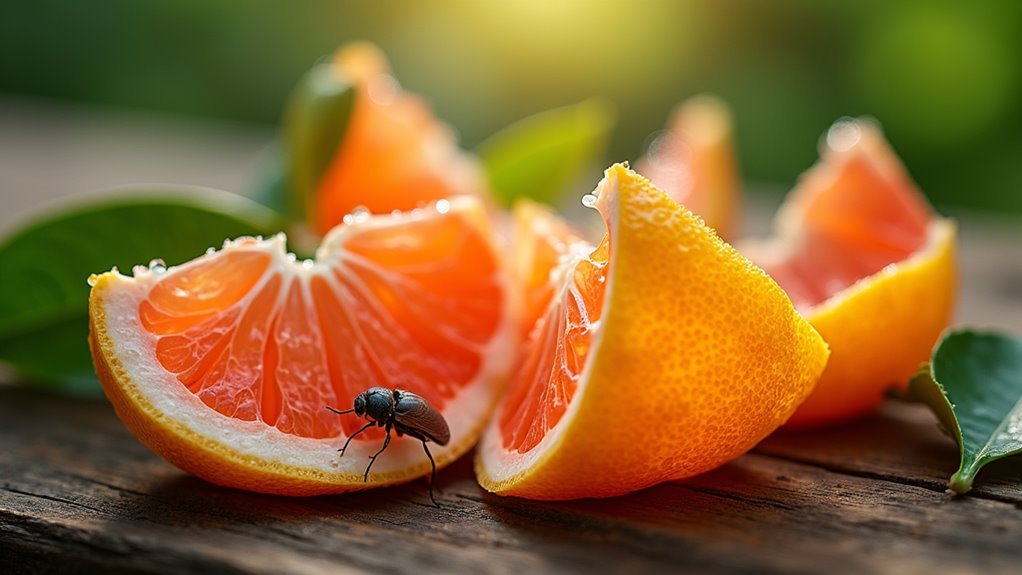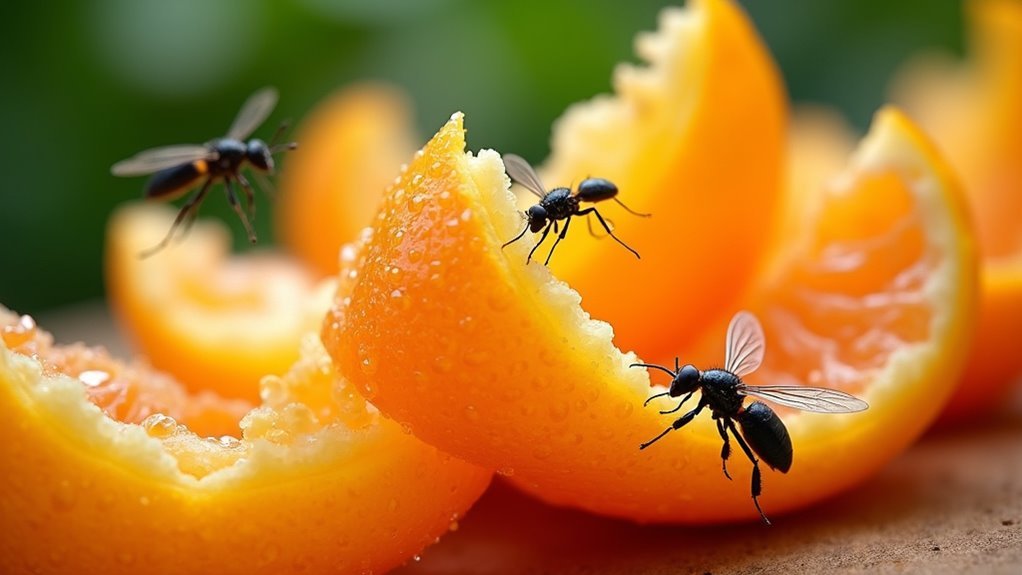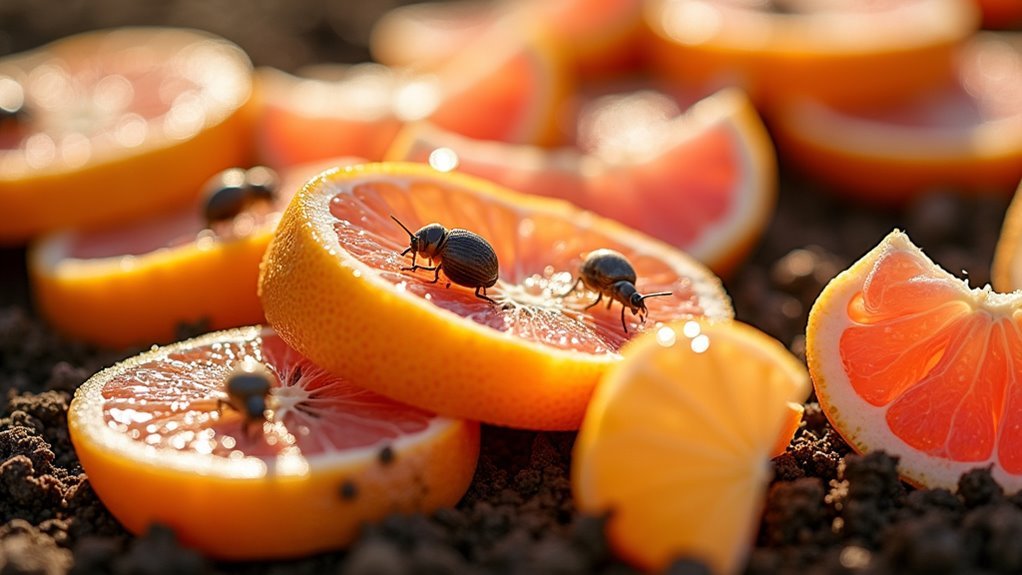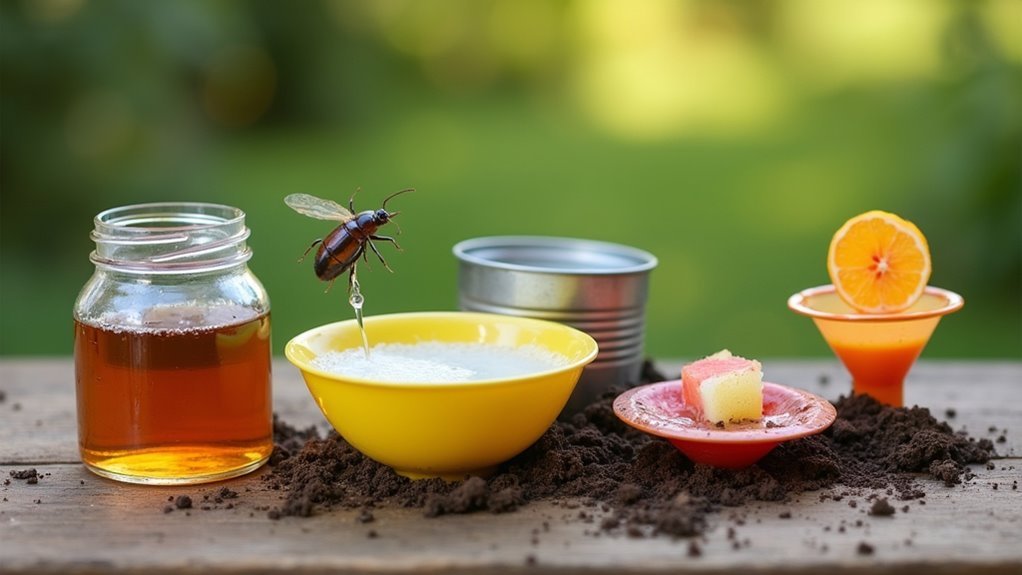Grapefruit peels repel garden pests through powerful natural compounds, primarily limonene, which makes up about 90% of citrus peel essential oil. This colorless hydrocarbon disrupts insects’ sensory receptors and navigation systems, interfering with their scent trails and masking food aromas that attract them. The peels also contain naringin, a flavonoid with insecticidal properties, and release volatile organic compounds that create an uninviting environment for mosquitoes, flies, ants, and other pests. You’ll discover the most effective application methods below.
The Science Behind Grapefruit’s Natural Compounds

When you’re searching for an eco-friendly way to protect your garden, grapefruit peels offer a scientifically-backed solution through their unique chemical composition.
These peels contain exceptionally high concentrations of limonene, a powerful natural compound that effectively disrupts pest sensory receptors. When you use grapefruit peels, the essential oils release volatile organic compounds that make your garden environment uninviting to mosquitoes, flies, and ants.
You’ll also benefit from naringin, a flavonoid with proven insecticidal properties against specific pest species. The natural compounds work together to mask attractive scents that typically draw pests to your plants.
This dual-action approach means grapefruit peels don’t just repel garden pests temporarily—they create a sustained protective barrier through their potent chemical arsenal.
Limonene: The Primary Active Ingredient
When you crush grapefruit peels, you’re releasing limonene, a powerful natural compound that’s your garden’s secret weapon against unwanted pests.
This citrus-scented chemical doesn’t just smell fresh—it actively disrupts insects’ ability to navigate by interfering with their scent trails.
You’ll find limonene works by creating an environment that mosquitoes, flies, and ants simply can’t tolerate, forcing them to seek other locations for their activities.
Limonene Chemical Properties
The secret behind grapefruit peels’ pest-repelling power lies in limonene, a colorless, flammable hydrocarbon that makes up roughly 90% of the essential oil found in citrus peels.
This terpene compound functions as a natural pest repellent through its unique chemical structure, which disrupts insects’ normal biological processes.
When you use grapefruit peels in your garden, limonene’s strong citrus fragrance effectively masks the food aromas that typically attract unwanted pests like ants and mosquitoes.
However, you’ll need to reapply frequently since limonene evaporates quickly, causing its repellent effectiveness to diminish rapidly.
Understanding these chemical properties helps you maximize this natural solution’s potential for keeping your garden pest-free.
Pest Repellent Mechanism
Because limonene disrupts insects’ neurological systems at the cellular level, it creates an inhospitable environment that drives pests away from treated areas.
This pest repellent mechanism works by interfering with insects’ sensory pathways, making your garden less attractive to unwanted visitors like mosquitoes and flies.
The limonene in grapefruit peels affects pests through three key ways:
- Sensory disruption – It confuses insects’ ability to locate food sources and navigate.
- Neurological interference – It impacts their nervous system function at cellular levels.
- Environmental deterrence – It creates an actively hostile atmosphere for pest survival.
You’ll find this natural compound more concentrated in grapefruit peels than orange peels, potentially making them more effective.
However, since limonene volatilizes quickly when released into air, you’ll need frequent reapplications to maintain protection.
How Citrus Scents Disrupt Pest Behavior

As grapefruit peels release their potent citrus aroma, they emit limonene and other volatile compounds that directly interfere with pests’ olfactory receptors.
The powerful citrus oils in grapefruit peels create a natural chemical disruption that overwhelms insects’ ability to detect food sources.
When you place these citrus peels around your garden, you’re fundamentally jamming the insects’ navigation systems. The strong scent masks the attractive odors that normally guide pests to their food sources, leaving them confused and disoriented.
You’ll notice that fresh peels work most effectively since they contain higher concentrations of essential oils.
As these compounds evaporate, they create an invisible barrier that many insects can’t penetrate. Mosquitoes, flies, and other garden pests rely heavily on smell for survival, so when citrus peels repel pests by overwhelming their sensory capabilities, they’re forced to search elsewhere for sustenance.
Grapefruit Peels Vs Orange Peels for Pest Control
When choosing between grapefruit and orange peels for pest control, grapefruit peels pack a more powerful punch due to their higher limonene concentrations.
You’ll notice grapefruit peels deliver superior pest-repelling performance compared to orange peels in several key ways:
- Stronger scent intensity – Grapefruit peels release more potent volatile organic compounds that effectively mask food aromas attracting pests.
- Broader pest coverage – Their distinct chemical composition deters a wider variety of garden invaders than orange peels.
- Enhanced short-term effectiveness – Higher potency provides more pronounced repelling effects despite quick evaporation.
While both citrus options work similarly, grapefruit peels offer greater versatility for your pest control needs.
Remember to compost used peels rather than leaving them directly in your garden to avoid attracting unwanted wildlife.
Which Garden Pests Are Most Affected

You’ll find that grapefruit peels work best against soft-bodied insects like aphids and whiteflies, which can’t tolerate the limonene compounds as well as harder-shelled pests.
Crawling insects such as ants and certain beetles become disoriented by the strong citrus scent that disrupts their navigation patterns.
Flying pests like gnats and some moths also show sensitivity to grapefruit peel compounds, though their aerial mobility can help them escape the concentrated oils more easily than ground-dwelling insects.
Soft-Bodied Insect Targets
Since grapefruit peels contain potent compounds like limonene and nootkatone, they’re particularly effective against soft-bodied garden pests that can’t withstand citrus-based deterrents.
These citrus peels work as a natural pest repellent by disrupting the feeding patterns and behavior of vulnerable insects.
You’ll find grapefruit peels most effective against these soft-bodied targets:
- Aphids – These tiny green or black insects cluster on plant stems and leaves.
- Whiteflies – Small white flying insects that damage plants by sucking sap.
- Spider mites – Microscopic pests that create fine webbing on plants.
The citrus scent creates an unwelcoming environment that these pests actively avoid.
For best results, you’ll want to apply fresh peels regularly around affected plants and combine this method with other pest control strategies to maximize effectiveness.
Crawling Pest Vulnerabilities
Beyond their effectiveness against flying insects, grapefruit peels excel at deterring ground-dwelling pests that navigate your garden through scent trails and surface exploration.
You’ll find these peels particularly effective against ants and cockroaches, as their high limonene concentration disrupts these pests’ nervous systems while masking the food odors that guide their foraging behavior.
Slugs and snails face a double challenge when encountering grapefruit peels. The natural bitterness makes them unappealing as food sources, while the citrus compounds create an unwelcoming environment.
When you strategically place fresh peels around vulnerable plants, you’re establishing protective barriers that crawling pests actively avoid. The strong scent confuses their navigation patterns, forcing them to seek alternative routes away from your protected garden areas, making grapefruit peels an excellent natural solution to repel these troublesome invaders.
Flying Insect Sensitivity
When grapefruit peels release their aromatic compounds into the air, flying insects experience immediate sensory disruption that sends them searching for more hospitable environments.
The limonene in these peels interferes with their navigation systems, while nootkatone creates an unwelcoming barrier that’s particularly effective against specific species.
Flying insects most affected by grapefruit peels include:
- Mosquitoes – Limonene disrupts their sensory receptors, making it harder for them to locate targets.
- Aphids – Nootkatone proves especially potent against these plant-damaging pests.
- Whiteflies and fruit flies – Both species actively avoid areas where fresh grapefruit peels are present.
You’ll notice the strongest repellent effects when you use fresh peels, as their volatile compounds are most concentrated during this time.
Proper Application Methods for Maximum Effectiveness
To maximize grapefruit peels’ pest-repelling power, you’ll need to prepare them properly before application. Chop or grind the peels into small pieces to enhance essential oil release that effectively deters pests. Scatter these prepared peels around plant bases and problem areas to create protective barriers against unwanted insects.
| Application Method | Frequency | Effectiveness |
|---|---|---|
| Fresh chopped peels | Every 2-3 days | High initial impact |
| Dried ground peels | Weekly | Sustained deterrent |
| Combined with herbs | Every 4-5 days | Maximum protection |
You’ll want to reapply your pest repellent regularly since essential oils dissipate over time. Combine grapefruit peels with other natural deterrents like herbs or essential oils for enhanced results. Monitor pest activity closely and adjust placement and frequency based on what you observe working against specific garden invaders.
Duration and Longevity of Repellent Properties
Although grapefruit peels offer promising pest-repelling benefits, their effectiveness doesn’t last indefinitely in your garden. The repellent properties of fresh grapefruit peels diminish rapidly due to the volatile nature of their active compounds, particularly limonene.
You’ll need to understand these key factors affecting longevity:
- Fresh peels maintain potency for 2-3 days before volatile oils evaporate and scent diminishes.
- Dried peels lose effectiveness quickly as moisture content and active compound concentrations drop markedly.
- Composted peels extend usefulness by releasing nutrients slowly while retaining some deterrent qualities.
You’ll achieve best results by replacing fresh grapefruit peels every few days.
Don’t expect long-lasting protection from a single application, as the natural compounds that make these peels effective are also what causes their rapid degradation in outdoor conditions.
Fresh Vs Dried Grapefruit Peels: What Works Better
Fresh grapefruit peels deliver considerably more pest-repelling power than their dried counterparts due to their higher concentrations of volatile oils like limonene. When you use fresh peels, you’re getting maximum effectiveness from these essential oils that evaporate as peels dry out.
| Factor | Fresh Grapefruit Peels | Dried Peels |
|---|---|---|
| Essential Oil Content | High concentration | Markedly reduced |
| Scent Strength | Strong, masks food aromas | Weak or absent |
| Pest Repelling Power | Maximum effectiveness | Diminished capabilities |
| Application Timing | Use immediately after peeling | Limited usefulness |
| Replacement Frequency | Every few days | Ineffective regardless |
You’ll find that dried peels lose their repellent capabilities as volatile compounds evaporate. For best results, you should apply fresh grapefruit peels immediately after removing them from the fruit and replace them regularly to maintain their pest-deterring qualities in your garden.
Expert Opinions on Citrus Peel Effectiveness
You’ll find that garden experts remain skeptical about grapefruit peels as reliable pest deterrents, with most pointing to the lack of solid scientific evidence supporting their long-term effectiveness.
Professional entomologists like John Tooker emphasize that while citrus peels might offer some temporary benefits, they can’t provide consistent or dependable pest control on their own.
Justin Hancock and other specialists warn that you shouldn’t rely on these peels as your primary defense against garden pests due to their rapidly diminishing potency.
Scientific Evidence Lacking
When you examine the scientific literature, you’ll find that experts remain skeptical about grapefruit peels’ effectiveness as garden pest deterrents.
The reality is that scientific evidence lacking supports citrus peels as reliable pest repellents.
Here’s what research reveals about grapefruit peels’ limitations:
- Insufficient active compounds – The limonene concentrations in grapefruit peels are too low to effectively repel pests, requiring much higher amounts than naturally present.
- Short-lived effectiveness – Essential oils and volatile compounds dissipate rapidly once peels dry out, eliminating any potential pest-deterring properties.
- Unintended consequences – You might actually attract larger pests rather than repel target ones, creating bigger garden problems.
While anecdotal reports persist, the scientific community emphasizes that more rigorous research is needed before recommending grapefruit peels as legitimate pest control methods.
Professional Skepticism Explained
Skepticism among horticultural professionals runs deep regarding grapefruit peels’ pest control capabilities. Experts like Justin Hancock and John Tooker question the long-term effectiveness of citrus peels, emphasizing that volatile compounds dissipate rapidly.
You’ll find that fresh peels may emit pleasant scents with initial repellent qualities, but these compounds lose potency as they dry and oils evaporate.
The limonene content in dried peels isn’t concentrated enough to produce significant deterrent effects. Scientific evidence supporting citrus peels as garden pest repellents remains lacking, prompting experts to call for more research.
Instead of relying on grapefruit peels, professionals recommend proven alternatives like encouraging beneficial insects and using organic insecticides for effective pest management in your garden.
Potential Risks and Drawbacks of Using Grapefruit Peels
While grapefruit peels offer a natural approach to pest control, they come with several significant drawbacks you should consider before implementing this method in your garden.
The reality is that grapefruit peels may actually work against your pest management goals. Rather than repelling unwanted visitors, they can attract snails and slugs, potentially increasing damage to your plants. The oils responsible for any repellent properties evaporate quickly, making this pest deterrent ineffective within a short timeframe.
Additional concerns include:
- Aesthetic problems – Peels create a cluttered, unkempt garden appearance.
- Slow decomposition – Their waxy skin and low moisture content lead to waste buildup.
- Lack of scientific support – No research validates their effectiveness as pest control.
You’ll likely find more reliable results using proven pest management strategies.
Combining Grapefruit Peels With Other Natural Methods
Despite these limitations, you can maximize grapefruit peels’ pest-repelling potential by incorporating them into an extensive natural management system.
You’ll enhance effectiveness by combining grapefruit peels with essential oils like peppermint or eucalyptus, creating a powerful natural pest repellent against mosquitoes and aphids.
Mix peels with organic materials such as diatomaceous earth or neem oil for multi-faceted protection. This approach targets different pest vulnerabilities while protecting beneficial organisms.
You should integrate beneficial insects and physical barriers alongside grapefruit peels to build a resilient garden ecosystem.
Regularly rotate placement of peels and other deterrents to prevent pests from adapting.
This thorough strategy transforms simple grapefruit peels into part of a sophisticated, environmentally-friendly pest management system that’s more effective than any single method alone.
When Grapefruit Peels May Attract Unwanted Wildlife
Although grapefruit peels effectively deter many garden pests, they can inadvertently attract unwanted wildlife that creates new problems for your garden.
The strong citrus scent that repels insects can actually draw raccoons and rodents to your space. These animals find the fragrance appealing and may cause significant damage while foraging.
Additionally, decomposing peels create favorable conditions for snails and slugs, potentially worsening your pest situation.
When grapefruit peels attract pests and wildlife, you’ll face several challenges:
- Plant damage from animals digging and foraging around peel locations
- Soil disruption that affects your garden’s overall health and appearance
- Increased maintenance to address new pest control issues
Consider composting peels instead of direct garden placement to avoid attracting wildlife while still benefiting your soil.
Composting Grapefruit Peels for Soil Benefits
When you compost grapefruit peels, they’ll release nitrogen and other essential nutrients as they decompose, creating a slow-release fertilizer that feeds your plants over months.
You’ll need to wait 3-6 months for the peels to fully break down, though chopping them into smaller pieces can cut this time in half.
The decomposition process transforms the peels into nutrient-rich humus that’ll improve your soil’s structure and support beneficial microorganisms.
Nutrient Release Process
Transformation occurs when you add grapefruit peels to your compost pile, revealing a treasure trove of nutrients for your garden soil. The nutrient release process begins as microbial activity breaks down the tough, waxy skin of grapefruit peels, gradually revealing essential elements your plants crave.
During decomposition, you’ll benefit from three key nutrients:
- Nitrogen – Promotes lush, green foliage growth
- Phosphorus – Strengthens root development and flowering
- Potassium – Enhances disease resistance and fruit quality
This slow release guarantees your plants receive steady nutrition over time.
Since grapefruit peels contain low moisture, you’ll accelerate the nutrient release process by chopping them into smaller pieces before composting. The increased microbial diversity created during breakdown supports a thriving soil ecosystem.
Composting Time Requirements
Six months to a year – that’s the timeframe you’ll need for grapefruit peels to fully decompose in your compost pile.
Understanding composting time requirements helps you plan when nutrient-rich compost will be ready for your garden.
You can greatly reduce decomposition time by chopping grapefruit peels into smaller pieces before adding them to your pile.
This simple step breaks down the tough citrus skin more quickly.
Regular turning accelerates the process by maintaining proper aeration throughout your compost.
Turn your pile every two to three weeks to guarantee grapefruit peels decompose efficiently.
During this decomposition period, the grapefruit peels release valuable nitrogen and potassium into your compost.
Once fully broken down, they’ll improve your soil’s structure and water retention capacity.
Commercial Citrus-Based Alternatives That Actually Work
While fresh grapefruit peels provide modest pest deterrent effects, commercial citrus-based alternatives deliver concentrated essential oils like limonene that’ll give you markedly better results in your garden.
These specialized products are formulated with additional ingredients that enhance efficacy and longevity compared to DIY citrus solutions.
You’ll find they target specific pests more effectively while maintaining their repellent properties longer than fresh peels, which lose potency quickly.
Here are three key advantages of commercial citrus products to repel garden pests:
- Enhanced concentration – Orange and grapefruit oil sprays contain higher essential oil levels
- Slow evaporation – Designed to maintain effectiveness over extended periods
- Reduced attraction risks – Won’t draw unwanted animals like discarded peels might
You’ll achieve more consistent pest control with these targeted formulations.
Frequently Asked Questions
Are Grapefruit Peels Good for the Garden?
You can use grapefruit peels in your garden as they’ll repel some pests with their limonene oils and add nutrients when composted. However, they’re slow to decompose and might attract unwanted wildlife.
What Animals Do Citrus Peels Repel?
You’ll find citrus peels repel ants, mosquitoes, and fruit flies effectively due to limonene. They may deter raccoons and deer, though research is limited. However, they can attract slugs and snails instead.
Do Citrus Peels Keep Bugs Away?
You’ll find citrus peels offer limited bug repelling effects due to limonene compounds. They’re only effective short-term while fresh, and you shouldn’t rely on them alone for pest control.
Why Should You Place Orange Peels Around Your Patio?
You should place orange peels around your patio because they’ll create a natural pest barrier through limonene, mask food aromas that attract insects, and provide an eco-friendly way to recycle waste.
In Summary
You’ve discovered that grapefruit peels pack a powerful punch against garden pests thanks to limonene and other citrus compounds. While they’re effective against many insects, you’ll need to watch for unwanted wildlife attraction. Don’t rely solely on peels—combine them with other natural methods for best results. Whether you’re using fresh peels, composting them, or choosing commercial alternatives, you’ve got science-backed options to protect your garden naturally.





Leave a Reply